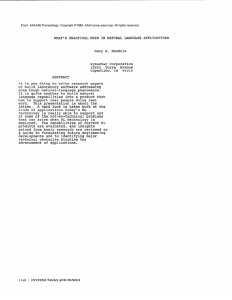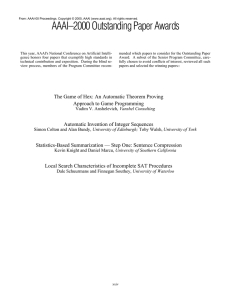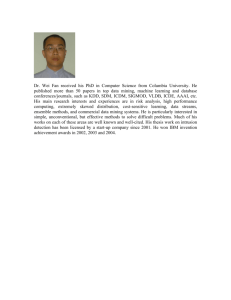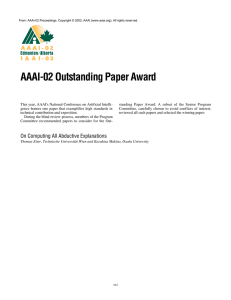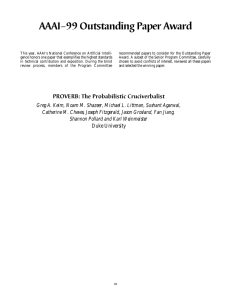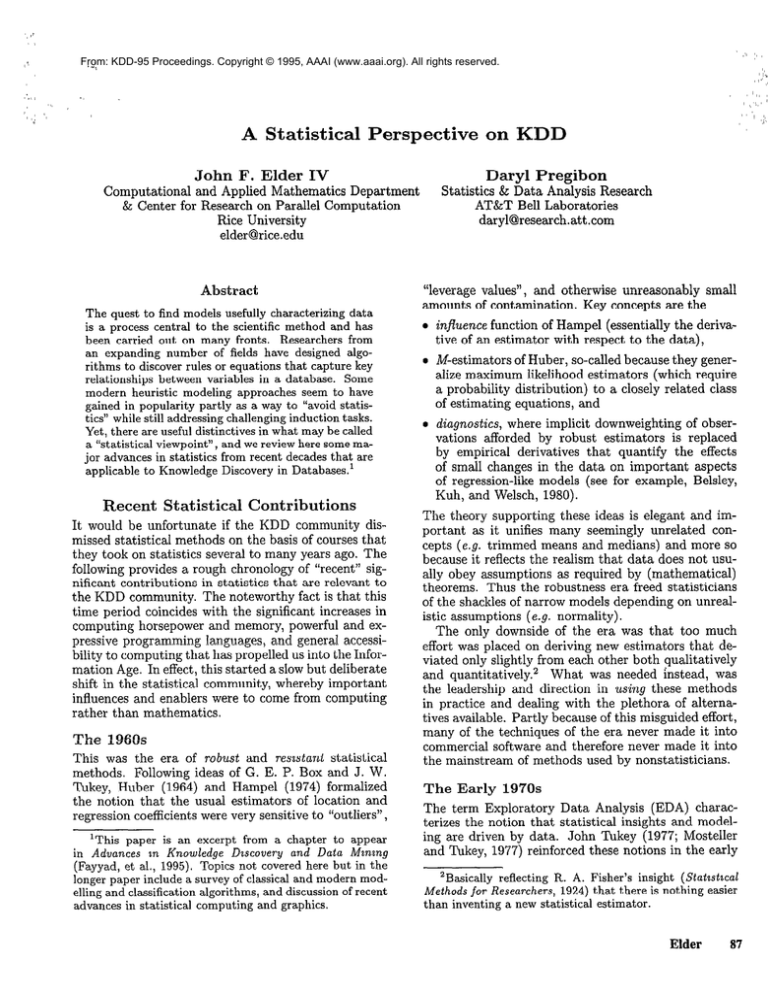
From: KDD-95 Proceedings. Copyright © 1995, AAAI (www.aaai.org). All rights reserved.
A Statistical
John F. Elder
Perspective
IV
Daryl
Computational and Applied Mathematics Department
& Center for Research on Parallel Computation
Rice University
elder@rice.edu
The quest to find models usefully characterizing data
is a process central to the scientific method and has
been carried out on many fronts. Researchers from
an expanding number of fields have designed algorithms to discover rules or equations that capture key
relationships between variables in a database. Some
modern heuristic modeling approaches seem to have
gained in popularity partly as a way to “avoid statistics” while still addressing challenging induction tasks.
Yet, there are useful distinctives in what may be called
a “statistical viewpoint”, and we review here some major advances in statistics from recent decades that are
applicable to Knowledge Discovery in Databases.’
Statistical
Contributions
nrnssive
=-----.
- nmu2mmin~
r--o------.----o
Ia.nkwswes.
--.o--o--,
and
-__-
wnarxl
o-------
ilcmwi_1-__LL-
bility to computing that has propelled us into the Information Age. In effect, this started a slow but deliberate
shift in the statistical community, whereby important
influences and enablers were to come from computing
rather than mathematics.
The 1960s
This was the era of robust and resastanl statistical
methods. Following ideas of G. E. P. Box and J. W.
Tukey, Huber (1964) and Hampel (1974) formalized
the notion that the usual estimators of location and
regression
coefficients
were very sensitive
-^
--I
__^^
“s,llIt3
to “outliers”,
‘This paper is an excerpt from a chapter to appear
in Advances zn Knowledge
Dascovery and Data Mznzng
flhnrnrl
et.
Tnnirs
here but in the
\--JJ--,
-- al.
--., 1995).
---c,.
--=.-- not
_.-A covered
..
longer paper include a survey of classical and modern modelling and classification algorithms, and discussion of recent
advances in statistical computing and graphics.
I>
)
and
-LL^.--:^“LIlW
amounts of contamination.
WISC
-.-_^^,.^-ulIIaaa”llauly
L,-
,-..I,
sil‘lall
Key concepts are the
influence function of Hampel (essentially the derivative of an estimator with respect to the data),
M-estimators of Huber, so-called because they generalize maximum likelihood estimators (which require
a probabiiity distribution) to a closeiy reiated ciass
of estimating equations, and
diagnostics, where implicit downweighting of observations afforded by robust estimators is replaced
by empirical derivatives that quantify the effects
of small changes in the data on important aspects
of regression-like models (see for example, Belsley,
Kuh, and Welsch, 1980).
mr- - LX. --_.-.
It would be unfortunate if the KDD community dismissed statistical methods on the basis of courses that
they took on statistics several to many years ago. The
following provides a rough chronology of “recent” significant contributions in statistics that are relevant to
the KDD community. The noteworthy fact is that this
time period coincides with the significant increases in
computing horsepower and memory, powerful and ex-
Pregibon
Statistics & Data Analysis Research
AT&T Bell Laboratories
daryl@research.att.com
‘II ^--^-ltwera~e
Recent
on KDD
one armory
____-- --L1-suppurwig
LL--:_1--611ese ~ueas
t- -l----L
IS wega~~~
---I
mu
:IIII-
portant as it unifies many seemingly unrelated concepts (e.g. trimmed means and medians) and more SO
because it reflects the realism that data does not usually obey assumptions as required by (mathematical)
theorems. Thus the robustness era freed statisticians
of the shackles of narrow models depending on unrealistic assumptions (e.g. normality).
The only downside of the era was that too much
effort was piaced on deriving new estimators that deviated only slightly from each other both qualitatively
and quantitatively.2
What was needed instead, was
the leadership and direction in using these methods
in practice and dealing with the plethora of alternatives available. Partly because of this misguided effort,
many of the techniques of the era never made it into
commercial software and therefore never made it into
the mainstream of methods used by nonstatisticians.
The Early
1970s
The term Exploratory
Data Analysis
(EDA)
charac-
terizes the notion that statistical
insights and modeling are driven by data. John Tukey (1977; Mosteller
and Tukey, 1977) reinforced these notions in the early
‘Basically reflecting R. A. Fisher’s insight (Statzstacal
for Researchers, 1924) that there is nothing easier
than inventing a new statistical estimator.
Methods
Elder
87
From: Proc. of the 1st Int'l . Conference on Knowledge Discovery and Data Mining. Copyright © 1995, AAAI (www.aaai.org). All rights reserved.
age, and data splitting, e.g., setting aside outliers to
70’s using a battery of ultra-simple
methods, e.g., what
could be done with pencil and paper. But the deeper
message was to dispel the traditional
dogma stating
that one was not allowed to “look at the data prior to
modeling”.
On the one side the argument was that hypotheses and the like must not be biased by choosing
them on the basis of what the data seem to be indicating. On the other side was the belief that pictures and
numerical summaries
of data are necessary in order to
understand
how rich a model the data can support.
A key notion in this era characterized
statistical
modeling as decomposing
the data into structure
and
noise,
data = fit f residual
(1)
and then examining
residuals
to identify and move
additional
structure
into the fit. The fitting process
would then be repeated
and followed by subsequent
residual analyses.
The iterative process described above has its roots
in the general statistical
paradigm of partitioning
variability into distinct
parts (e.g., explained
and unexplained variation;
or, in classification,
within-group
and between-group
variation).
The EDA notion simply uses the observed scale of the response rather than
the somewhat unnatural
squared units of “variability”.
While this might seem like a trivial distinction,
the difference is critical since it is only on the observed scale
that diagnosis and treatment
is possible. For example,
a component
of variance can indicate that nonlinearity
is present but cannot prescribe how to accommodate
it.
Graphical methods (not to be confused with graphical models in Bayes nets) enjoyed a renaissance
during
this period as statisticians
(re-)discovered
that nothing outperforms
human visual capabilities
in pattern
recognition.
Specifically,
statistical
tests and models
focus on expected values, and in many cases, it is the
unexpected
that upsets or invalidates
a model (e.g.,
outliers).
Tukey argued that (good) graphical methods should allow unexpected
values to present themselves - once highlighted,
models can be expanded or
changed to account for them.
Another important
contribution
was to make data
Statistics
has
description
respectable
once more.
its roots in earlier times when descriptive
statistics
reigned and mathematical
statistics
was only a gleam
in the eye. Data description
is concerned with simplicity and accuracy, while not being overly formal about
quantifying
these terms (though an important
area of
research tries to do just that; e.g., Mallows (1973),
Akaike (1973), and Rissanen
(1978)).
A key notion
popularized
in this era was that there is seldom a single right answer - in nearly all situations
there are
Effective data description
highlights
many answers.
those that are simple, concise, and reasonably
accurate. Simple transformations
of a dataset are used to
effect such descriptions,
the two most common ones
being data reezppression, e.g., using log(age) instead of
88
KDD-95
simplify
The
the description
Late
of the bulk of the data.
1970s
To an outsider much of the statistical
literature
would
seem fragmented
and disjoint.
But the fact of the
matter is that much is closely related, but that specific details of individual
contributions
hide the real
similarities.
In the late 70’s, two review papers and
one book elegantly captured the essence of numerous
prior publications.
The first of these, Generalized Linear Models (Nelder and Wedderburn,
1974; McCullagh
and Nelder, 1989) extended the classical linear model
to a much wider class that included probability
models
other than the normal distribution
and structural
models that were nonlinear.
The theory accomplished
this
by decomposing
the variation
in a response variable
into systematic
and random components,
allowing the
former to capture covariate effects through a strictly
monotone
link function, g(p) = C xjfij, and allowing
the latter to be a member of the exponential
family of
distributions,
&(,~,o). In so doing, these models provided a unifying theory for regression-like
models for
binary and count data, as well as continuous
data from
asymmetric
distributions.
The second major review
paper is well known outside of statistics
as the EM
algorithm
(Dempster,
Laird, and Rubin, 1977). This
paper neatly pulled together numerous
ways of solving estimation
problems with incomplete
data.
But
the beauty of their general treatment
was to instill the
concept that even if data are complete, it is often useful to treat it as a missing value problem for computational purposes.
Finally, the analysis of nominal or
discrete data, specifically counts, had several disconnected streams in the literature
and inconsistent
ways
to describe relationships.
Bishop, Fienberg,
and Holland (1975) pulled this material together into the class
of loglinear models. The associated theory allowed researchers to draw analogies to models for continuous
data (for example, analysis of variance ideas) and further provided computational
strategies for estimation
and hypothesis testing. It is also noteworthy
that this
work anticipated
current work in so-called graphical
models, a subset of the class of loglinear models for
nominal data.
The
Early
1980s
Resampling
methods had been around since the late
1950s under the moniker jackknife, so-named by Tukey
because it was a “trusty general purpose tool” for eliminating low-order bias from an estimator
(Schreuder,
1986). The essence of the procedure is to replace the
original n observations
by n or more (possibly) correlated estimates of the quantity of interest (called psuedovalues). These are obtained by systematically
leaving out one or more observations
and recomputing
the
estimator.
More precisely, if 0 is the parameter
of in-
From: Proc. of the 1st Int'l . Conference on Knowledge Discovery and Data Mining. Copyright © 1995, AAAI (www.aaai.org). All rights reserved.
terest, the ith psuedovalue is defined by
pt = T-d,11- (n - k)fLi
(2)
where the last quantity is the estimator fi based on
leaving out the ith subset (of size k). The jackknife estimate of 0 is the arithmetic mean of the psuedovalues,
P = CpJn.
reduction tool, it was quickly recognized that the ordinary standard deviation of the psuedovalues provides
an honest estimate of the error in the estimate. Thus
an empirical means of deriving a measure of uncertainty for virtually ang, statistical estimator was available. One interpretation of the procedure is that the
construction of psuedovaiues is baaed on repeatedly
and systematically sampling without replacement from
the data at hand. This led Efron (1979) to generalize
the concept to repeated sampling with replacement, the
so-called bootstrap (since it allowed one to “pick oneself
up by the bootstraps” in constructing a confidence interval or standard error). This seemingly trivial insight
opened the veritable flood gates for comprehensive analytic study and understanding of resampling methods. The focus on estimating precision of estimators
rather than bias removal coupled with the advance of
computing resources, allowed standard errors of highly
nonlinear estimators to be routinely considered.
Unfortunately, as with robustness, the bulk of the
research effort was directed at theoretical study of reI(DD
researchers
wolJ!d
recv,rd
‘sxmnlintr
---r----b iclnn.s
----- in--- w&
o--as uninteresting situations. The most nonlinear procedures, such as those resulting from combining model
identification and model estimation, received only cursory effort (e.g. Efron and Gong, 1983; Faraway, 1991).
and nonlinear features. But by interpreting a scatterplot smoother as an estimate of the conditional mean
E(ylz), one obtains an adaptive, nonlinear estimate of
the effect of I on the distribution of y. Moreover, this
nonlinearity could be tamed while simultaneously reducing bias caused by end-effects, by enforcing “local”
linearity in the smoothing procedure (as opposed to
local constants as provided by moving averages or mediansj. Thus by moving a window across the data and
fitting linear regressions within the window, a globally
nonlinear fit is obtained, i.e. the sequence of predictions at each point z%, s,(z) = ai + by, where the coefficients a, and b, are determined by the least squares
regression of y on z for all points in the window centered on 2%.
This notion has been applied now in many contexts (e.g. regression, classification, discrimination)
and across many “error” distributions (e.g. the generalized additive model of Hastie and Tibshirani, 1985).
While this work reduced the emphasis on strict linearity of the explanatory variables in such models, it did
not ameliorate the need for having previously identified
the relevant variables to begin with.
The Early
1990s
Within the statistics community, Friedman and Tukey
(1974) pioneered the notion of allowing a model to
adapt even more nonlinearly by letting the data determine the interesting structure present with ‘Lprojection
pursuit” methods. These are less restrictive than re,,A-3
---I!..
---~ ---Al-J-, buc.11
,..,I- BS ncXird iStWO&,
-._kuxa
xiwuinear
rne6nuab
supposing a model of the form
(3)
k=l
The Late 1980s
One might characterize classical statistical methods as being “globally” linear whereby the explanatory jprediction jciassification variabies affect the distribution of the response variable via linear combinations. Thus the effect of x3 on y is summarized by
a single regression coefficient &. Nonlinear relationships could only be modeled by specifically including
the appropriate nonlinear terms in the model, e.g. x32
or log x3. Cleveland (1979) helped seed the notion that
globally linear procedures could be replaced with locally linear ones by employing scatterplot smoothers
in interesting ways. A scatterplot smoother s(x) is a
data-dependent curve defined pointwise over the range
of 2. For example, the moving average smoother is defined at each unique x, as the mean g(x) = Ctc
of the k (symmetric) nearest neighbors of c.
ordered sequence of these pointwise estimates traces
out a “smooth” curve through the scatter of (2.~)
\ I”,
points. Originally smoothers were used simply to enhance scatterplots where clutter or changing density of
plotted points hindered visual interpretation of trends
j=1
where both the regression coefficients /3jk and the
squashing functions gk () are unknown.
Important algorithmic developments and theory resulted from these models even though they failed to
achieve widespread use within the statistics community. Part of the reason was that these models were
regarded as too flexible in the sense that arbitrarily
complex functions could be provably recovered (with
big enough K). The community instead retreated back
to additive models that had limited flexibility but afforded much greater interpretability.
Indeed, interpretability was the focus of much of the work in this era
as alternative formulations of the locally linear model
were derived, e.g., penalized likelihood and Bayesian
formulations (O’Sullivan et al. 1986).
Still, these ambitious methods helped to nudge
the community from focusing an model estimation to
model selection. For example, with tree-based models (Breiman et al 1984) and multiple adaptive regression splines (Friedman 1991), the modeling search is
over structure space as well as parameter space. It is
not uncommon now for many thousands of candidate
Elder
89
From: Proc. of the 1st Int'l . Conference on Knowledge Discovery and Data Mining. Copyright © 1995, AAAI (www.aaai.org). All rights reserved.
structures to be considered in a modeling run - which
forces one to be even more conservative when judging
whether improvements are significant, since any measure of model quality optimized by a search is likely
to be over-optimistic. When considering a plethora of
candidates it usually becomes clear that a wide variety
of models, with different structures and even inputs,
score nearly as well as the single “best”. Current research in Bayesian model averaging and model blending combines many models to obtain estimates with reduced variance and (almost always) better accuracy on
new data (e.g., Wolpert, 1992; Breiman, 1994b). Such
techniques seem especially promising when the models being merged are from completely different families
(for example, trees, polynomials, kernels, and splines).
Distinctives
of Statistical
Practice
Researchers from different fields seem to emphasize different qualities
in the models they seek. As with work-
ers in Machine Learning and KDD (but unlike most
using, say, neural network and polynomial network
techniques), Statisticians are usually interested in znterpretzng their models and may sacrifice some performance to be able to extract meaning from the model
structure. If the accuracy is acceptable they reason
that a model which can be decomposed into revealing
parts is often more useful than a “black box” system,
especially during early stages of the investigation and
design cycle.
Statisticians are also careful to propagate uncertainty (or randomness) in sampled data to estimated
models, summarizing the induced randomness by socalled sampling distributions of estimators. By judicious assumptions, exact sampling distributions are
analytically tractable; more typically asymptotic arguments are invoked. The net result is often the same,
the estimated parameters are approximately normally
distributed.
This distribution characterizes the uncertainty in the estimated parameters, and owing to
normality, the uncertainty is succinctly captured in
the standard deviation of the sampling distribution,
termed the standard error of the estimate. Parameters
associated with estimates that are small in comparison
to their standard errors, (e.g., t = p/.s.e.(&
< 2) are
not likely to be part of the “true” underlying
generating the data, and it is often prudent
for training
but
additional
information
is
needed to regularize the fit.
to drop
larization criteria include model complexity
(e.g., number of parameters),
roughness (e.g., integrated squared
3The Bayesian paradigm provides a different though related perspective where one treats the parameter itself as a
random variable and merges prior beliefs about the parameter together with observed data. The resulting posterior
distribution, p(8ldata), can often itself be approximated by
a normal distribution,
and thereby a single number summary of parameter uncertainty is available. Of course, recent computational advances and ingenious algorithms (e.g.
Markov chain monte carlo) obviate the need for analytically
derived normal approximations.
KDD-95
employed
process
such parameters from the model. 3
90
An important consideration that statisticians have
faced concerns the case where inferences are desired
but data is sparse. Consider an example from retail
marketing. An SKU (stock keeping unit) is a unique label assigned to a retail product, for example, men’s size
12 blue socks. Predictions of SKUs are required at a
store level in a large chain of department stores to build
up sufficient inventory for promotions and seasonal demand or other “predictable” events. The problem is
that detailed historical data on individual SKU sales
at each and every store in the chain is not available;
for example, it may be that no men’s size 12 blue socks
sold in the Florida store since last November. The concept of borrowing strength allows one to build forecasts
at the site-SKU level by exploiting hierarchies in the
problem, possibly in more ways than one. By aggregating across stores, sufficient information is available
to build a site-independent prediction for each SKU.
This prediction can be used to add stability to predictions of SKUs in each of several regions, which can in
turn be used to add stability at the site level. Similar types of decompositions could allow us to borrow
strength by looking at sales of, say, all blue socks independent of size, then all socks, then men’s undergarments, then menswear overall. Such “hierarchical
models” have their origins in empirical Bayes models,
so-called because inferences are not truly Bayesian, as
maximum likelihood estimates are used in place of “hyperparameters” (the parameters in prior distributions)
at the highest levels of the hierarchy where data is most
numerous. This typically results in estimates of the
form 6%= cwg,+ (1 - cr)~ where fit is the estimate specific to the zth level of the hierarchy and g to that of
its parent (where data is more abundant). The mixing
parameter, a, captures the similarity of the individual
estimate to its parent relative to the tightness of the
distribution of the &‘s.
The tradeoff between model “underfit” (bias) and
“overfit” (variance) is a standard one in statistics. If
data are plentiful, model overfit can be avoided by
reserving representative subsets of the data for testing as the model is constructed. When performance
on the test set systematically worsens, model growth
is curtailed. With limited data, all the cases can be
Some examples of regu-
slope of its response surface), and parameter shrinkage,
(e.g., parameters are smoothly shrunken toward zero).
The criterion to be minimized is a weighted sum of the
training error and regularization criteria: criterion =
model-accuracy +cux regularization-penalty.
The scalar Q is most usually chosen using some
form
of cross-validation,
K methods.
e.g., bootstrap
Most regularization
or leave-out-
procedures have a
Bayesian interpretation
whereby the user-defined prior
guides the direction and degree of regularization.
From: Proc. of the 1st Int'l . Conference on Knowledge Discovery and Data Mining. Copyright © 1995, AAAI (www.aaai.org). All rights reserved.
Finally, although some of the appeal of nontraditional models and methods undoubtedly stems
from their apparent ability to bypass statistical analysis stages many see as cumbersome, it is clear that
matching the assumptions of a method with the characteristics of a problem is beneficial to its solution. Statistical analysts usually take the useful step of checking
those assumptions; chiefly, by examining:
1. residuals (model errors)
2. diagnostics (model sensitivity to perturbations)
3. parameter covariances (redundancy)
Not all violations of assumptions are equally bad. For
example, assumptions about stochastic behavior of the
data are typically less important than the structural
behavior; the former might lead to inefficient estimates or inaccurate standard errors, but the later could
result in biased estimates. Within these two broad
classes, normality and independence assumptions are
typically less important than homogeneity of variance
(e.g., var(ylz) = constant for all z). A single outlier
from the structural model can bias the fit everywhere
else. Likewise, leverage values are those observations
that have undue influence on the fit? for example if
deleting the ith observation results in a large change
in the estimate of a key parameter. An important distinction is that leverage values need not correspond to
large residuals - indeed by virtue of their “leverage”,
they bias the fit toward themselves resulting in small or
negligible residuals. Colinearzty among the predictor
variables confuses the interpretation of the associated
parameters, but can also be harmful to prediction; the
new data must strictly abide by the interrelationships
reflected in the training data or the model will be extrapolating beyond the confines of the training space,
rather than interpolating within it.
Reservations
to Automatic
Modeling
The experienced statistician, perhaps the most capable of guiding the development of automated tools for
data analysis, may also be the most acutely aware of
all the difficulties that can arise when dealing with real
data. This hesitation has bred skepticism of what automated procedures can offer and has contributed to
the strong focus by the statistical community on model
estimation to the neglect of the logical predecessor to
this step, namely model identification.
Another culprit underlying this benign neglect is the close historical connection between mathematics and statistics
whereby statisticians tend to work on problems where
theorems and other analytical solutions are attainable
(e.g. sampling distributions and asymptotics). Such
solutions are necessarily conditional on the underlying model being specified up to a small number of
identifiable parameters that summarize the relationship of the predictor variables to the response variable
through the first few moments of the conditional distribution, f(ylz). For example the common regression
model takes the form:
j=l
4Y Ix) = constant
(5)
The implicit parameter J is not part of the explicit
formulation nor is the precise specification of which
xj’s define the model for the mean parameter /.J, Traditional statistics provides very useful information on
the sampling distribution of the estimates bj for a fixed
set of x3’s but no formalism for saying which x’s are
needed.
The relatively small effort by the statistical community in model identification has focused on marrying
computing horsepower with human judgment (as opposed to fully automated procedures). The general
problem is deciding how large or complex a model the
available data will support. By directly and explicitly focusing on mean squared prediction error, statisticians have long understood the basic tradeoff between
bias (too small a model) and variance (too large a
model) in model selection. Algorithms (Furnival and
w-7..
a^-^\
Wilson, lY’lt() and methods (Maiiows, iE3j have been
used extensively in identifying candidate models summarized by model accuracy and model size. The primary reason that human judgment is crucial in this
process is that algorithmic optimality does not and
cannot include qualitative distinctions between competing models of similar size - for example, if the accuracy/availability/cost
of the variables differ. So it is
largely human expertise that is used to select (or validate) a model, or a few models, from the potentially
large pools of candidate models.
The statistician’s tendency to avoid complete automation out of respect for the challenges of the data,
and the historical emphasis on models with interpretable structure, has led that community to focus on
problems with a more manageable number of variables
(a dozen, say) and cases (several hundred typically)
than may be encountered in KDD problems, which can
be orders of magnitude larger at the outset4 With increasingly huge and amorphous databases, it is clear
that methods for automatically hunting down possible
patterns worthy of fuller, interactive attention, are required. The existence of such tools can free one up
to, for instance, posit a wider range of candidate data
features and basis functions (building blocks) than one
would wish to deal with, if one were specifying a model
structure “by hand”.
This obvious need is gaining sympathy but precious
little has resulted. The subsections below highlight
some of the areas that further underlie the hesitation
of automating model identification by statisticians.
4Final models are often of similar complexity; it’s the
magnitude of the initial candidate set of variables and cases
that is usually larger in KDD.
Elder
91
From: Proc. of the 1st Int'l . Conference on Knowledge Discovery and Data Mining. Copyright © 1995, AAAI (www.aaai.org). All rights reserved.
Statistical
versus
practical
significance
A common approach to addressing the complexity and
size of model space is to limit model growth in the
model fitting/learning
stage. This is almost always accomplished using a statistical test of significance at
each step in the incremental model building stage.
Thus for example, one could use a standard x2 test
of independence between two nominal variables as a
means to limit growth of a model that searches for
“significant” association. The main problem with this
approach is that significance levels depend critically
on n, the sample size, such that as n increases, even
trivial differences attain statistical significance. Statisticians ameliorate this problem by introducing context
to better qualify findings as “significant.”
Simpson’s
paradox
A related problem with automated search procedures
is that they can often be completely fooled by anomalous association patterns, even for small datasets. An
accessible and easily understood example (Freedman,
Pisani, and Purves, i978) concerns admission to graduate school at UC Berkeley in 1973. Across major
departments, 30% of 1835 female applicants were admitted while 44% of 2691 male applicants were admitted. Do these disparate fractions indicate sex bias? On
the face yes, but if the applicants and admissions are
broken down by department, then the fractions of the
two sexes admitted shows a very different story, where
one might even argue that “reverse” sex bias is present!
The “paradox” here is that the choice of major is confozlnded with sex - namely that females tend to apply
to
mainrs that
1_ ----.d--L
d--... are
.~~ harder to get into while males apply
to “easy” majors.
The implication of this paradox is that KDD tools
which attack large databases looking for ‘(interesting” associations between pairs of variables must also
contain methods to search for potential confounders.
Computationally,
this changes the problem from an n2
to an n3 operation (or higher if one considers more
confounders). The computational burden can only be
avoided by providing knowledge about potential confounders to the discovery algorithm. While this is in
principle possible, it is unlikely to be sufficient since
common sense knowiedge often suggests what confounders might be operating. Statisticians have long
brought these common sense insights to the problem
rather than delegate them to automata.
Select ion bias
Automated knowledge discovery systems are applied
to databases with the expectation of translating data
into information. The bad news is that often the available data is not representative of the population of
interest and the worse news is that the data itself con--^,.^-I.
tains no hint that there is a p0ieiiiid
“vias p~laaau6.
Namely, it’s more an issue of what is not in a data
92
KDD-95
set rather than what information it contains. For example 5, suppose that the White House Press Secretary is using a KDD (e.g. information
retrieval)
tool to browse through email messages to PRESIDENT@WHITEHOUSE.GOV
for those that concern
health care reform. Suppose that she finds a 1O:l ratio
of pro-reform to anti-reform messages, leading her to
assert that “Americans favor reform by a 1O:l ratio”
followed by the worrisome rejoinder “and Government
can fix it.” But it may well be that people dissatisfied
with the health care system are more like& to “sound
off” about their views than those who are satisfied.
Thus even if the true distribution of views on health
care reform has mean “score” of zero, self-selected samples that are heavily biased toward s one of the tails of
this distribution will give a very misleading estimate
of the true situation. It is not realistic to expect automated tools to identify such instances. It is probably
even less realistic to expect users (e.g. lawyers) of such
systems to critically question such interesting “facts.”
Quantifying
Visual
Capabilities
Today’s data analyst is very dependent on interactive
analysis where numerical and graphical summaries are
computed or displayed “on the fly”.
Successful instances of data mining by statisticians are often sprinkled with cries of “aha” whereby some subject matter (context) information, or unexpected behavior in
a plot, is discovered in the course of the interaction
with the data. This discovery can change the intended
course of subsequent analysis steps in quite unpredictable ways. Assuming that it is a very hard problem to include common sense and context information
in automated modeling systems, this leaves automated
interpretation of plots as a promising area to explore.
There are two problems that have served as a barrier
to statisticians in this regard:
1. it is hard to quantify
unexpected in plots.
a procedure
to capture the
2. even if this could be accomplished, one would need
to describe how this maps into the next analysis step
in the automated procedure.
TXTL..L
----,-. --,A,2
_..-,,..., :-ID CL
9
“Y llab :-IS aulaly
Ilccut;u :,111Al.,.
Cllt: ,+n+:n+:m:nno
3bcbblrlLILla113
cLllU”lJ
way to represent meta-knowledge about the problem at
hand and about the procedures commonly used. This
suggests an opportunity where the KDD and statistical communities can complement their skills and work
together to provide an acceptable and powerful solution.
5A less modern but more realistic situation occurred
in US politics when three major polls overwhelmingly
projected Dewey over Truman in the 1948 presidential election
-too
bad for Dewey (the Republican) that there was a dis---II--- -..L,C_
_-1 AL--. ..&I. -La-,.
crepancy between the vo~mg
puanc ana
~rnux .WLL~I
~LLVLL~;
service.
From: Proc. of the 1st Int'l . Conference
Copyright © Annals
1995, AAAI
All rights reserved.
Summaryon Knowledge Discovery and Data Mining.
the jackknife.
of (www.aaai.org).
Statistics 7: l-26.
Numerous powerful analytic techniques, applicable to
problems of Knowledge Discovery in Databases, have
emerged from the field of statistics in recent decades
- especially as the influence of computing has grown
over that of mathematics.
“Thinking in statistical
terms” clau
-n- LA
I..^ I:L.. “I-+ --J-lUC .A.,,
YIbcl.1+b” CL,
bllt: qum,lJy
111uue1sZ-J.---J
111uuceu
from data. In particular, the tendency of the statistical community to propagate uncertainty in their
models through sampling distributions, their familiarity with the need to regularize models (trade off accuracy and complexity), and their perseverance in checking model assumptions and stability (through residual and graphical analyses) are strengths. KDD researchers can learn from these perspectives in order to
improve the performance and stability of their techniques Similarly, KDD, machine learning, and neural
network techniques have gained in popularity partly as
a way of “avoiding statistics”. Statisticians can learn
from this the need to do a better job of communicating their methods, as well as clarifying and streamlining ways of injecting meta-data information into the
modeling process.
References
Akaike, H. 1973. Information Theory and an Extension
of the Maximum Likelihood Principle. In Proceedings
of the Second International Symposium on Information
Theory, eds. Petrov and Csaki, 267-281, Budapest:
Kiado Academy.
Belsley, D. A.; Kuh, E.; and Welsch, R. E. 1980. Regression Diagnostics: Identafying influentaal data and
sources of collinearity. New York: John Wiley & Sons.
Bishop, Y. M. M.; Fienberg, S. E.; and Holland, P.
W. 1975. Discrete Multivariate Analysis: Theory and
Practice. Cambridge, Massachusetts: MIT Press.
Breiman, L. 199413. Stacked Regressions, Technical Report 367, Dept. Statistics? UC Berkeley.
Breiman, L.; Friedman, J. H.; Olshen, R. A.; and
Stone, C. J. 1984. Classification and Regression Trees.
Monterey, California: Wadsworth & Brooks.
Cleveland, W. S. 1979. Robust locally weighted regression and smoothing scatterplots.
Journal of the
American Statistical. Association 74: 829-836.
Dempster, A. P.; Laird, N. M.; and Rubin, D. B. 1977.
Maximum likelihood from incomplete data via the EM
algorithm (with discussion). Journal of the Royal Statist?:cal
Societw Y -R 2%
--* I-38.
Efron, B.; and Gong, G. 1983. A leisurely look at the
bootstrap, the jackknife, and cross-validation. American Statistician 37: 36-48.
Efron, B. 1979. Bootstrap
Faraway, J. J. 1991. On the cost of Data Analysis,
Technical Report 199, Dept. Statistics, Univ. Michigan, Ann Arbor.
Fayyad, U. M.; Piatetsky-Shapiro, G; Smyth, P; and
Uthurusamy, R. 1995 (in press). Advances in Knowledge Discovery and Data Mining. AAAI/MIT
Press.
Freedman, D.; Pisani, R.; and Purves, R. 1978. Statzstics. New York: WW Norton & Co.
Friedman, J. H. 1991. Multiple Adaptive Regression
Splines (with discussion). Annals of Statistics 19: l141.
Friedman, J. H.; and Tukey, J. W. 1974. A Projection Pursuit Algorithm for Exploratory Data Analysis.
IEEE Transactaons on Computers 23: 881-889.
F‘nmiwi.
) C-.
M . --_2nd
-.-.,
Wilann
. . ^-yy..)
R
_l,
W. . . A”
lQ7A8 A. &C”pU”“‘“AA
‘ROOTOC~~OTT
by leaps and bounds. Technometrics 16: 499-511.
Hampel, F. R. 1974. The influence curve and its role in
robust estimation. Journal of the American Statistical
Association 62: 1179-1186.
Hastie, T.; and Tibshirani, R. 1990. Generalized Additive Models. London: Chapman & Hall.
Huber, P. J. 1964. Robust estimation of a location
parameter. Annals of Mathematical Statistics 35: 73101.
manows, C. L. i973. Some Comments on Cp.
nometrics 15: 661-675.
,Tech-
McCullagh, P.; and Nelder, J. A. 1989. Generalized
Linear Models (2nd Ed.) London: Chapman & Hall.
Mosteller, F.; and Tukey, J. W. 1977. Data Analysis and Regressaon. Reading Massachusetts: AddisonWesley.
Nelder, J. A.; and Wedderburn, R. W. M. 1972. Generalized Linear Models. Journal of the Royal Statistical
Society A 135: 370-384.
O’Sullivan, F.; Yandell, B. S.; and Raynor, W. J. Jr.
1986. Automatic smoothing of regression functions in
generalized linear models. Journal of the American
Statistical Association 81: 96-103.
Rissanen, J. 1978. Modeling by Shortest Data Description. Automatica 14: 465-471.
Schreuder, H. T. 1986. Quenouille’s estimator. Encyclopedia of Statistical Science 7: 473-476. New York:
John Wiley & Sons.
Tukey, J. W. 1977. Exploratory Data Analysis. Reading, Massachusetts: Addison--Wesiey.
Wolpert, D. 1992. Stacked Generalization.
Networks 5: 241-259.
Neural
methods: Another look at
Elder
93

